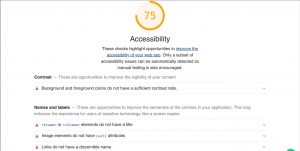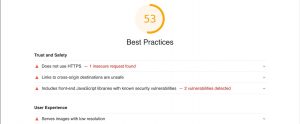15 Jul Do NOT Ignore Google’s Website Update Called Page Experience
Your website rankings may plunge, taking your customer acquisition with it!

Google updates its search engine algorithm updates several hundreds of times a year. Mostly with small changes, but once in a while, a large update takes effect. For 2021, that update is the Google Page Experience Update.
What is it?
First of all, let’s explain what Google wants to see. The smart folks at Google want to see web surfers using its platform to have a great experience. That includes providing rankings that are most beneficial to what a person is searching for. When someone clicks on a link, that link should open the website quickly, be viewable on any device, and contain excellent content that helps the user.

So the Page Experience Update includes a lot of metrics that go into evaluating whether or not a website will meet the exacting standards. If it doesn’t, that website’s rankings will SUFFER. Potentially big time to the point of a colossal drop in traffic.
For a business that relies on organic (non-paid) web traffic for customer acquisition, that may spell a revenue disaster!
What to do?
The good news is, Google has not kept the Page Experience Update a secret. Unlike previous updates, Google pretty much laid out the information being evaluated in a way that effectively has let us see behind the “curtain” and prepare.
At GoogChecker, we have kept very close tabs on exactly what Google has stated will be evaluated. In fact, that’s how we created the GoogChecker auditing tool!
So the first step is to understand the specifics of the Update. Google created Core Web Vitals to measure the KPI’s of a website. There are three overriding metrics that will be used as follows:
- Largest Contentful Pain (LCP) – This has to do with website loading performance. Google considers it a good user experience when the largest item on the page loads within 2.5 seconds of when the page first begins loading. Up to 4 seconds is acceptable, anything longer than that will be considered “POOR”.
- First Input Delay (FID) – This metric looks at how long it takes for the website to respond when a user clicks on something. This may be a link, a header, button, etc. A good user experience should have an FID under 100 milliseconds, but definitely under 300 milliseconds.
- Cumulative Layout Shift (CLS) – This metric looks at visual stability. As a user scrolls through the web page, does the content jump around? If so, the visual stability will be affected.
When we created GoogChecker, we looked intricately at all aspects of the Google Page Experience Update to not only audit the issue, but also to show users what can be done to fix them.
Here is a sample of the top of a GoogChecker Web Report (website unnamed)
Performance Part of the Audit

The initial score of 39 for Performance looks at LCP, FID, and CLS as described above for loading times. While the CLS for the website is excellent at 0.027, the LCP is over 3 times what is acceptable at 13.9 seconds! The FCP is in the “Needs Work” category.
Thankfully, you don’t need to understand how to fix these issues. Thankfully, the GoogChecker team will do it for you!

Accessibility Part of the Audit
Another part of the Google Page Experience Update involves Accessibility. To put it simply, Google wants to make the Experience of a website accessible to as broad a range of individuals as possible. This includes individuals who have affected vision in some way, motor impairment, hearing difficulties, or cognitive impairment.
Look at this part of the report:

While it’s cut off a bit, you can see that GoogChecker evaluates the Contrast of content to make sure it’s adequate for those with affected vision. In addition, the auditor checks to see if images have alt tags. For users who cannot see the website images, it’s helpful to know what the image is of.
Best Practices
This next section is fairly eclectic. It includes website security, vulnerability, and coding issues.

While the sample website does have an active SSL Certificate (for https://), there appears to be an issue with the website pulling in an image from a non-secure source. This should be fixed.
The security vulnerabilities mentioned refers to third-party content that is known to be often exploited by hackers. If you have been a victim of ransomware (or know someone), this should be reason enough to be fixed immediately!
The Final Analysis
While aspects of the report may seem a bit overwhelming, it’s important to understand that the people at Google are some of the smartest in the WORLD. This is why GoogChecker audits websites in a very granular manner to understand very specifically where the problems are, and how bad they are.
We have found that over 90% of websites have at least one area that is in the POOR category and should have those areas fixed. So don’t feel bad if yours has 2 or more areas that are POOR!!
GoogChecker’s team of veteran web developers and coders fixes the problems associated with the Page Experience update. We’re happy to help you fix yours, and prevent the algorithm from destroying your rankings. Visit our Packages page to see how we help, or simply give us a call for a FREE consult at (888) 714-8514 today.
